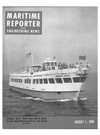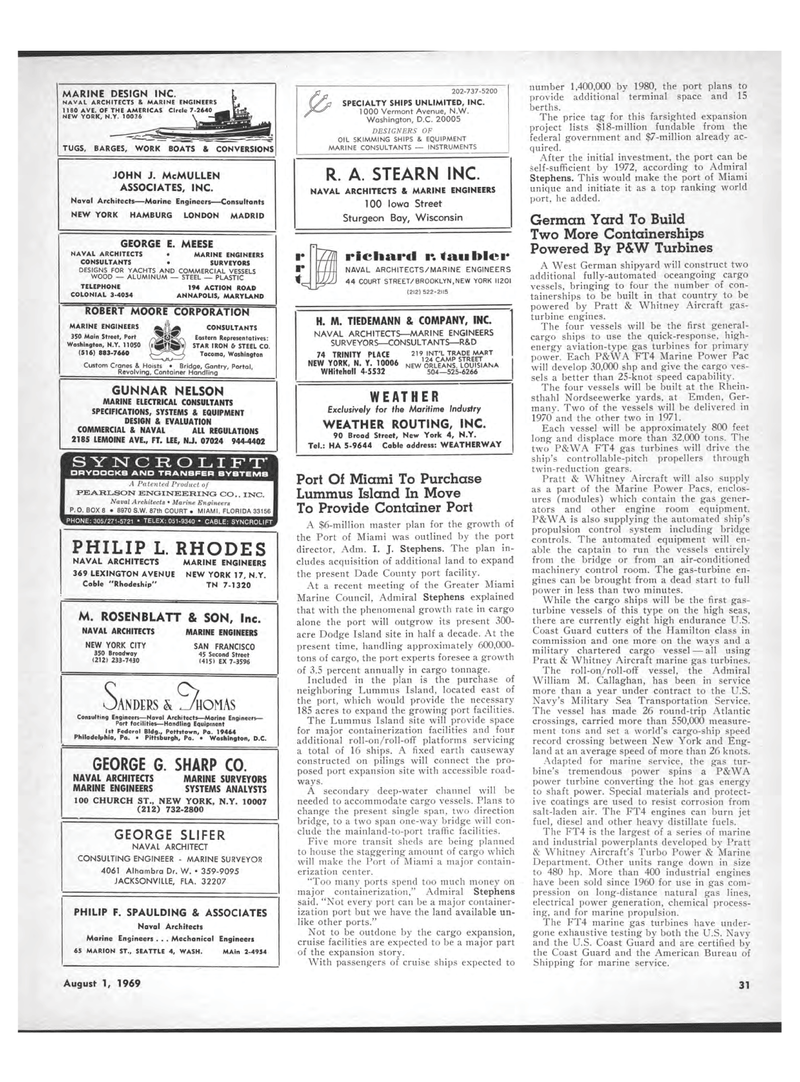
Page 29: of Maritime Reporter Magazine (August 1969)
Read this page in Pdf, Flash or Html5 edition of August 1969 Maritime Reporter Magazine
MARINE DESIGN INC. NAVAL ARCHITECTS & MARINE ENGINEERS 1180 AVE. OF THE AMERICAS Circle 7-2640 NEW YORK, N.Y. 10036 TUGS, BARGES, WORK BOATS & CONVERSIONS JOHN J. McMULLEN ASSOCIATES, INC. Naval Architects?Marine Engineers?Consultants NEW YORK HAMBURG LONDON MADRID GEORGE E. MEESE NAVAL ARCHITECTS . MARINE ENGINEERS CONSULTANTS ? SURVEYORS DESIGNS FOR YACHTS AND COMMERCIAL VESSELS WOOD ? ALUMINUM ? STEEL ? PLASTIC TELEPHONE 194 ACTION ROAD COLONIAL 3-4054 ANNAPOLIS, MARYLAND ROBERT MOORE CORPORATION MARINE ENGINEERS 350 Main Street, Port Washington, N.Y. 11050 (516) 883-7660 CONSULTANTS Eastern Representatives: STAR IRON & STEEL CO. Tacoma, Washington Custom Cranes & Hoists ? Bridge, Gantry, Portal, Revolving, Container Handling GUNNAR NELSON MARINE ELECTRICAL CONSULTANTS SPECIFICATIONS, SYSTEMS & EQUIPMENT DESIGN & EVALUATION COMMERCIAL & NAVAL ALL REGULATIONS 2185 LEM0INE AVE., FT. LEE, N.J. 07024 944-4402 SYNCROLIFT' DRYDOCK8 AND TRANSFER SYSTEMS A Patented Product of PEARLSON ENGINEERING CO.. INC. Naval Architects ? Marine Engineers '.O. BOX 8 « 8970 S.W. 87th COURT . MIAMI, FLORIDA L src. I , 33156 I PHONE: 305/271-5721 ? TELEX: 051-9340 ? CABLE: SYNCROLIFT PHILIP L. RHODES NAVAL ARCHITECTS MARINE ENGINEERS 369 LEXINGTON AVENUE NEW YORK 17, N.Y. Cable "Rhodeship" TN 7-1320 M. ROSENBLATT & SON, Inc. NAVAL ARCHITECTS MARINE ENGINEERS NEW YORK CITY 350 Broadway (212) 233-7430 SAN FRANCISCO 45 Second Street (415) EX 7-3596 Sanders & [ Thomas Consulting Engineers?Naval Architects?Marine Engineers? Port facilities?Handling Equipment 1st Federal Bldg., Pottstown, Pa. 19464 Philadelphia, Pa. ? Pittsburgh, Pa. ? Washington, D.C. GEORGE G. SHARP CO. NAVAL ARCHITECTS MARINE SURVEYORS MARINE ENGINEERS SYSTEMS ANALYSTS 100 CHURCH ST., NEW YORK, N.Y. 10007 (212) 732-2800 GEORGE SLIFER NAVAL ARCHITECT CONSULTING ENGINEER - MARINE SURVEYOR 4061 Alhambra Dr. W. ? 359-9095 JACKSONVILLE, FLA. 32207 PHILIP F. SPAULDING & ASSOCIATES Naval Architects Marine Engineers . . . Mechanical Engineers 65 MARION ST., SEATTLE 4, WASH. MAin 2-4954 202-737-5200 SPECIALTY SHIPS UNLIMITED, INC. 1 000 Vermont Avenue, N.W. Washington, D.C. 20005 DESIGNERS OF OIL SKIMMING SHIPS & EQUIPMENT MARINE CONSULTANTS ? INSTRUMENTS R. A. STEARN INC. NAVAL ARCHITECTS & MARINE ENGINEERS 100 Iowa Street Sturgeon Bay, Wisconsin rich sir<1 r. tan bIe ?* NAVAL ARCHITECTS/MARINE ENGINEERS 44 COURT STREET/BROOKLYN,NEW YORK 11201 (212) 522-2115 H. M. TIEDEMANN & COMPANY, INC. NAVAL ARCHITECTS?MARINE ENGINEERS SURVEYORS?CONSULTANTS?R&D 74 TRINITY PLACE 219 INT'L TRADE MART NEW YORK, N. Y. 10006 NEW ORLEANS,loUIS^ANA WHitehall 4-5532 504-525-6266 WEATHER Exclusively for the Maritime Industry WEATHER ROUTING, INC. 90 Broad Street, New York 4, N.Y. Tel.: HA 5-9644 Cable address: WEATHERWAY Port Of Miami To Purchase Lummus Island In Move To Provide Container Port A $6-million master plan for the growth of the Port of Miami was outlined by the port director, Adm. I. J. Stephens. The plan in-cludes acquisition of additional land to expand the present Dade County port facility. At a recent meeting of the Greater Miami Marine Council, Admiral Stephens explained that with the phenomenal growth rate in cargo alone the port will outgrow its present 300-acre Dodge Island site in half a decade. At the present time, handling approximately 600,000-tons of cargo, the port experts foresee a growth of 3.5 percent annually in cargo tonnage. Included in the plan is the purchase of neighboring Lummus Island, located east of the port, which would provide the necessary 185 acres to expand the growing port facilities. The Lummus Island site will provide space for major containerization facilities and four additional roll-on/roll-off platforms servicing a total of 16 ships. A fixed earth causeway constructed on pilings will connect the pro-posed port expansion site with accessible road-ways. A secondary deep-water channel will be needed to accommodate cargo vessels. Plans to change the present single span, two direction bridge, to a two span one-way bridge will con-clude the mainland-to-port traffic facilities. Five more transit sheds are being planned to house the staggering amount of cargo which will make the Port of Miami a major contain-erization center. "Too many ports spend too much money on major containerization," Admiral Stephens said. "Not every port can be a major container-ization port but we have the land available un-like other ports." Not to be outdone by the cargo expansion, cruise facilities are expected to be a major part of the expansion story. With passengers of cruise ships expected to number 1,400,000 by 1980, the port plans to provide additional terminal space and 15 berths. The price tag for this farsighted expansion project lists $18-million fundable from the federal government and $7-million already ac-quired. After the initial investment, the port can be self-sufficient by 1972, according to Admiral Stephens. This would make the port of Miami unique and initiate it as a top ranking world port, he added. German Yard To Build Two More Containerships Powered By P&W Turbines A West German shipyard will construct two additional fully-automated oceangoing cargo vessels, bringing to four the number of con-tainerships to be built in that country to be powered by Pratt & Whitney Aircraft gas-turbine engines. The four vessels will be the first general-cargo ships to use the quick-response, high-energy aviation-type gas turbines for primary power. Each P&WA FT4 Marine Power Pac will develop 30,000 shp and give the cargo ves-sels a better than 25-knot speed capability. The four vessels will be built at the Rhein-sthahl Nordseewerke yards, at Emden, Ger-many. Two of the vessels will be delivered in 1970 and the other two in 1971. Each vessel will be approximately 800 feet long and displace more than 32,000 tons. The two P&WA FT4 gas turbines will drive the ship's controllable-pitch propellers through twin-reduction gears. Pratt & Whitney Aircraft will also supply as a part of the Marine Power Pacs, enclos-ures (modules) which contain the gas gener-ators and other engine room equipment. P&WA is also supplying the automated ship's propulsion control system including bridge controls. The automated equipment will en-able the captain to run the vessels entirely from the bridge or from an air-conditioned machinery control room. The gas-turbine en-gines can be brought from a dead start to full power in less than two minutes. While the cargo ships will be the first gas-turbine vessels of this type on the high seas, there are currently eight high endurance U.S. Coast Guard cutters of the Hamilton class in commission and one more on the ways and a military chartered cargo vessel ? all using Pratt & Whitney Aircraft marine gas turbines. The roll-on/roll-off vessel, the Admiral William M. Callaghan, has been in service more than a year under contract to the U.S. Navy's Military Sea Transportation Service. The vessel has made 26 round-trip Atlantic crossings, carried more than 550,000 measure-ment tons and set a world's cargo-ship speed record crossing between New York and Eng-land at an average speed of more than 26 knots. Adapted for marine service, the gas tur-bine's tremendous power spins a P&WA power turbine converting the hot gas energy to shaft power. Special materials and protect-ive coatings are used to resist corrosion from salt-laden air. The FT4 engines can burn jet fuel, diesel and other heavy distillate fuels. The FT4 is the largest of a series of marine and industrial powerplants developed by Pratt & Whitney Aircraft's Turbo Power & Marine Department. Other units range down in size to 480 hp. More than 400 industrial engines have been sold since 1960 for use in gas com-pression on long-distance natural gas lines, electrical power generation, chemical process-ing, and for marine propulsion. The FT4 marine gas turbines have under-gone exhaustive testing by both the U.S. Navy and the U.S. Coast Guard and are certified by the Coast Guard and the American Bureau of Shipping for marine service. August 1, 1969 31

 28
28

 30
30
